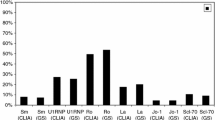Summary
The specificity of anti-nucleic acid antisera can immunocytochemically be evaluated with test systems which apply various nucleic acids immobilized to inert matrices. When using polyrA.polyrU as a model compoud for dsRNA, it is important to prevent the formation of the triple stranded form polyrA.(polyrU)2.
Anti-dsRNA antibodies which, when tested with the correct test system, proved to be present in an earlier described anti-DNA.RNA serum, could be removed by adsorption. By cytofluorometric comparison of the immunofluorescence signals obtained with the anti-dsRNA containing serum and the absorbed serum, it could be shown that the anti-dsRNA antibodies do not contribute to the specific signals measured after in situ hybridization.
Repetitive incubations with the anti-DNA.RNA serum led to a considerable increase in immunofluorescence signal.
Similar content being viewed by others
References
Alcover A, Izquierdo M, Stollar D, Miranda M, Alonso C (1981) Analytical studies of chromosomal transcription detected by an endogeneous hybridization technique (eht) using autoradiography and indirect immunofluorescence in Drosophila Hydei. Acta Embryol Morphol Exp 2:131–140
Bauman JGJ, Wiegant J, Van Duijn P (1981a) Cytochemical hybridization with fluorochrome-labelled RNA I. Development of the method using nucleic acids bound to agarose beads as a model. J Histochem Cytochem 29:227–246
Bauman JGJ, Wiegant J, Van Duijn P (1981b) Cytochemical hybridization with fluorochrome-labelled RNA II. Applications. J Histochem Cytochem 29:238–246
Bauman JGJ, Van der Ploeg M, Van Duijn P (1984) Fluorescent hybridicytochemical procedures: DNA/RNA hybridization in situ. In: Chayen J, Bitensky L (eds) Investigative techniques in medicine and microbiology. Marcel Dekker, New York, pp 41–88
Blake RD, Fresco JR (1966) Polynucleotides VII. Spectrophotometric study of the kinetics of formation of the two-stranded helical complex resulting from the interaction of polyriboadenylate and polyribouridylate. J Mol Biol 19:145–160
Blake RD, Massoulie J, Fresco JR (1967) Polynucleotides VIII. A spectral approach to the equilibria between polyriboadenylate and polyribouridylate and their complexes. J Mol Biol 30:291–308
Brahic M, Haase AT (1978) Detection of viral sequences of low reiteration frequency by in situ hybridization. Proc Natl Acad Sci USA 75:6125–6129
Brigati DJ, Myerson D, Leary JJ, Spalholz B, Travis SZ, Fong CKY, Hsiung GD, Ward DC (1983) Detection of viral genomes in cultured cells and paraffin-embedded tissue sections using biotin-labelled hybridization probes. Virology 126:32–50
Casey J, Davidson N (1977) Rates of formation and thermal stabilities of RNA.DNA and DNA.DNA duplexes at high concentrations of formamide. Nucl Acid Res 4:1539–1552
Frederiks WM (1976) Over lipiden in de celkern. Thesis, University of Amsterdam
Gu J, Islam KN, Polak JM (1983) Repeated application of first-layer antiserum improves immunofluorescence staining: a modification of the indirect immunofluorescence staining procedure. Histochem J 15:475–482
Kitagawa Y, Stollar BD (1982) Comparison of poly(A).poly(dT) and poly(I).poly(dC) as immunogens for the induction of antibodies to RNA.DNA hybrids. Mol Immunol 19:413–420
Landegent JE, Jansen in de Wal N, Baan RA, Hoeijmakers JHJ, Van der Ploeg M (1984) 2-acetylaminofluorene-modified probes for the indirect-hybridocytochemical detection of specific nucleic acid sequences. Exp Cell Res 153:61–72
Little PFR (1984) RNA probes prepared in vitro. Nature 309:191
Manuelidis L (1977) A simplified method for the preparation of mouse satellite DNA. Anal Biochem 78:561–568
Mol JNM, Borst P (1976) The binding of poly(rA) and poly(rU) to denatured DNA I. Model studies with homopolymers. Nucleic Acids Res 3:1013–1027
Prooijen-Knegt AC van, Redi CA, Ploeg M van der (1980) Quantitative aspects of the cytochemical Feulgen-DNA procedure studied on model systems and cell nuclei. Histochemistry 69:1–17
Prooijen-Knegt AC van, Hoek JFM van, Bauman JGJ, Duijn P van, Wool IG, Ploeg M van der (1982) In situ hybridization of DNA sequences in human metaphase chromosome visualized by an indirect fluorescent immunocytochemical procedure. Exp Cell Res 141:397–407
Renz M, Kurz C (1984) A colorimetric method for DNA hybridization. Nucl Acids Res 12:3435–3444
Reddy AR, Sofer W (1981) A rapid procedure to detect in situ DNA/RNA hybrids. Biochem Biophys Res Commun 103:959–967
Riley M, Maling B, Chamberlin MJ (1966) Physical and chemical characterization of two-and three-stranded adenine-thymine and adenine-uracil homopolymer complexes. J Mol Biol 20:359–389
Rudkin GT, Stollar BD (1977) High resolution detection of DNA-RNA hybrids in situ by indirect immunofluorescence. Nature 265:472–473
Shroyer KP, Nakane PK (1982) Use of DNP-labeled cDNA for in situ hybridization. J Cell Biol 97, 377a
Smeenk RJT (1983) Low avidity antibodies to dsDNA. Thesis, University of Amsterdam
Steiner M, Asselt S van, Borst P, Mol JNM, Kleisen CM, Newton BA (1973) Specific detection of kinetoplast DNA in cytological preparations of trypanosomes by in situ hybridisation with complementary RNA. Exp Cell Res 76:175–185
Stuart WD, Porter DL (1978) An improved in situ hybridization method. Exp Cell Res 113:219–222
Tchen P, Fuchs RPP, Sage E, Leng M (1984) Chemically modified nucleic acids as immunodetectable probes in hybridization experiments. Proc Natl Acad Sci USA 81:3466–3470
Author information
Authors and Affiliations
Additional information
This work was subsidized in part by Het Praeventiefonds, The Hague, The Netherlands
Rights and permissions
About this article
Cite this article
Raap, A.K., Marijnen, J.G.J. & van der Ploeg, M. Anti-DNA.RNA sera. Histochemistry 81, 517–520 (1984). https://doi.org/10.1007/BF00489529
Accepted:
Issue Date:
DOI: https://doi.org/10.1007/BF00489529




